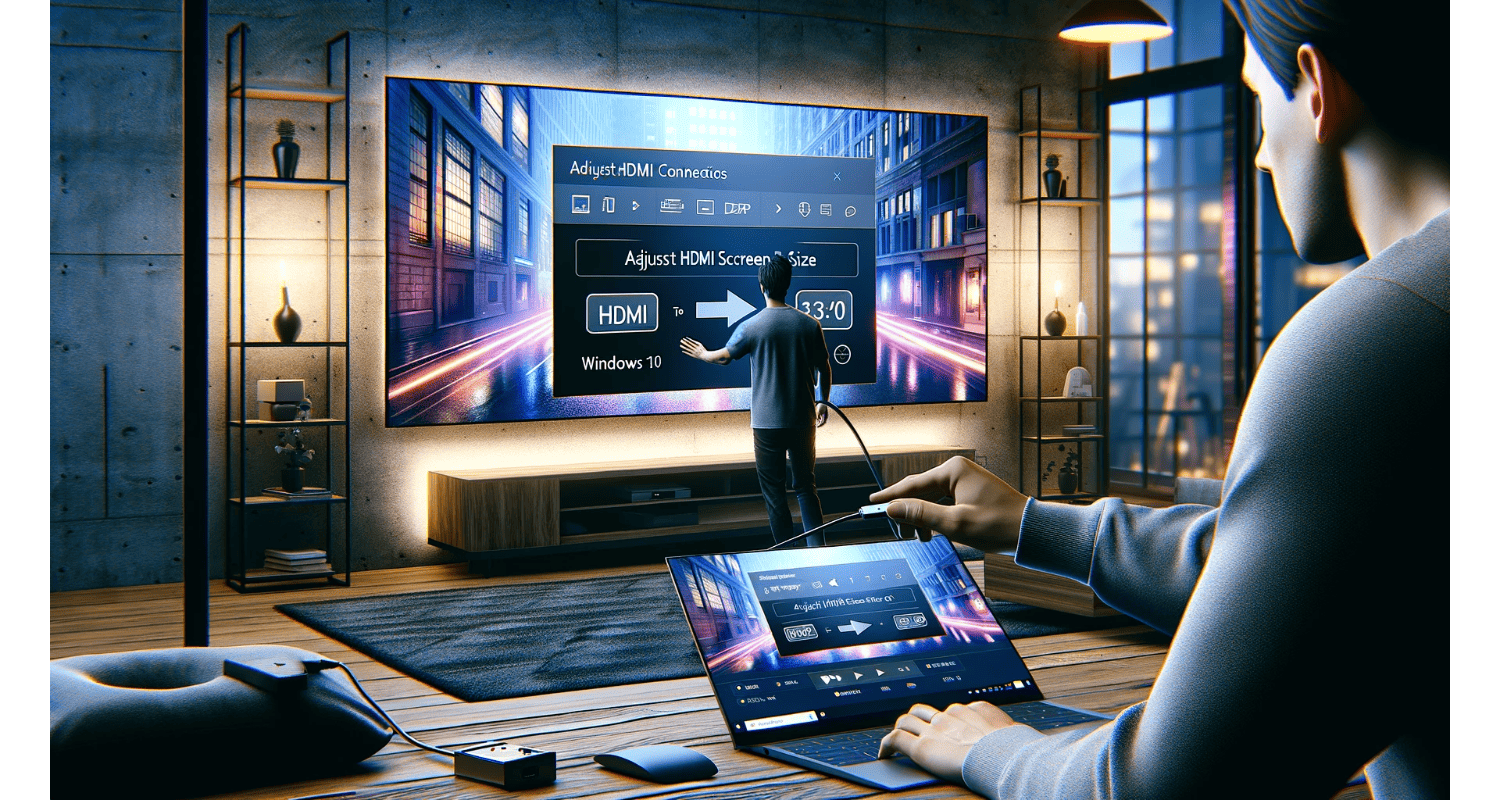Imagine this: You’re all set for a movie night, your favorite snacks in hand, ready to unwind. But as you fire up your Windows 10 laptop and connect it to the TV, something’s off. The screen doesn’t fit! It’s either too big, cutting off vital parts of the scene, or too small, leaving you squinting. Frustration mounts, doesn’t it? How to adjust HDMI screen size on TV from Windows 10? This isn’t just a minor inconvenience; it’s a mood killer, a barrier to relaxation and entertainment.
To adjust the HDMI screen size on your TV from Windows 10, right-click on your desktop and select “Display settings.” Under the “Scale and layout” section, adjust the resolution until it fits your TV screen. Sometimes, you may also need to adjust the TV’s aspect ratio or zoom settings.
But wait, there’s a solution within reach! This guide will not only define this common yet overlooked problem but will also provide a simple, step-by-step solution. How to adjust HDMI screen size on TV from Windows 10? Say goodbye to screen size woes and hello to perfect movie nights.
See Also: 4 Methods to Fix Default Gateway Is Not Available Error
Table of Contents
Understanding The Issue: Why Screen Size Doesn’t Fit
Have you ever connected your laptop to a TV and found the screen just doesn’t look right? This all-too-common issue of mismatched screen size, where the display on the TV doesn’t align with what you see on your laptop, can be frustrating. But why does this happen?
First up, let’s talk about overscaling. Imagine your computer screen as a canvas, and your TV as a frame. If the canvas is too big, parts of it won’t fit in the frame. That’s overscaling. It happens when the resolution of your computer doesn’t match the TV’s. Your laptop might be sending a 1080p signal, but your TV is stuck thinking, “I’m a 720p screen, what do I do with all this extra data?” It tries its best, but sometimes, the edges get cut off.
Next, there’s the issue of different resolutions to adjust HDMI screen size on TV from Windows 10. Think of resolution as the number of pixels packed into your screen. If your laptop and TV have different pixel counts, the image might appear too large or too small. It’s like trying to read a book where the words don’t fit on the page – annoying, right?
Outdated drivers can also be culprits. They’re like old road maps; they don’t have the latest routes. If your graphics driver is out-of-date, it might not be communicating effectively with your TV, leading to display issues. To ensure your drivers are up to date, especially when facing display issues, check out our guide on how to update your graphics drivers.
Lastly, there’s overscanning. It’s a relic from the old tube TV days, where TVs would zoom in slightly to avoid showing unwanted artifacts on the screen edges. Modern TVs still have this feature, and sometimes, it zooms in too much, making your computer’s display spill over the edges. So, there you have it – a mix of old and new tech issues causing your screen fit woes. But fear not, we’re here to fix that!
Step-By-Step Guide To Adjusting HDMI Screen Size
Adjusting the resolution in Windows 10 can often solve your screen fit issues. It’s like finding the right size of clothes for a perfect fit. Here’s how you do adjust HDMI screen size on TV from Windows 10:
- Right-Click On Desktop: Begin by right-clicking on an empty space on your desktop. This is your gateway to display settings.
- Open Display Settings: In the menu, click on “Display settings.” This is where the magic happens.
- Adjust Resolution: Scroll down to the “Scale and layout” section. Here, you’ll see “Display resolution.” Think of these as different sizes for your screen. If you’re having trouble navigating your TV’s menu or finding the right settings, our comprehensive article on adjusting HDMI screen size on TV from Windows 10 can be a helpful resource.
- Test And Apply: Select a resolution that matches your TV’s. Not sure what it is? No worries, try a few options! Click “Apply” to test each one. If it doesn’t look right, Windows will revert back after 15 seconds.
- Confirm Changes: Once you find the perfect fit, click “Keep changes.” And voilà! Your screen should now fit your TV.
Scaling Options In Windows
Sometimes, it’s not just about resolution, but how Windows scales on your TV and adjust HDMI screen size on TV from Windows 10:
- Access Display Settings: Right-click on your desktop.
- Find Scaling Options: Look for the “Scale and layout” section.
- Adjust Scale: You’ll see an option for scaling, usually set as 100%, 125%, etc. This adjusts the size of text, apps, and other items. Experiment with these settings until everything on your TV looks proportionate and fits well.
Adjusting Refresh Rate
The refresh rate is like the rhythm of your display. It needs to be in sync with your TV:
- Display Settings: Right-click on the desktop and open “Display settings.”
- Advanced Display Settings: Click on “Advanced display settings.”
- Refresh Rate Options: Click on “Display adapter properties,” then go to the “Monitor” tab. Here you’ll find “Screen refresh rate.”
- Select And Apply: Choose a refresh rate that your TV supports. This can reduce flickering and improve display compatibility.
See Also: Netflix Freezing Computer Problem | 4 Easy Fixes
Using TV Settings For Adjustment
Sometimes, the key to a perfectly sized screen lies not in your computer, but in your TV’s settings. It’s like adjusting the lens on a camera to get the perfect picture. One crucial setting to look out for is the “Overscan” option. This little feature, often hidden in the depths of your TV’s menu, can make a world of difference to adjust HDMI screen size on TV from Windows 10.
- Access TV Menu: Grab your TV remote and dive into the menu. This is where you’ll find the controls to fine-tune your screen.
- Find Picture Settings: Navigate to the “Picture” settings. This is the hub for all things display-related on your TV.
- Locate Overscan: Look for a setting named “Overscan,” “Picture Size,” or something similar. It’s like a secret lever that adjusts how your TV interprets the incoming signal.
- Disable Or Adjust Overscan: If you find an “Overscan” option, try turning it off. Or, if there’s a size adjustment, play around with it. Disabling overscan allows your TV to display the full image from your computer, without cropping out the edges.
By disabling or adjusting the overscan, you can often solve those annoying screen fit issues. It’s like finally getting the full picture in a jigsaw puzzle. With a combination of your computer’s settings and your TV’s capabilities, you can create a harmonious display that brings out the best in your movies, games, or presentations.
See Also: Why Does Netflix Keep Crashing On My TV: Quick Fixes And Solutions
Additional Tips And Troubleshooting
Even after adjusting your settings, you might encounter some hiccups. Here are some additional tips and troubleshooting strategies, gathered from various tech savvy sources, to adjust HDMI screen size on TV from Windows 10:
- Check Cable Quality: The HDMI cable is like the bridge between your computer and TV. Hence, ensure it’s high-quality and not damaged.
- Try Different HDMI Ports: Sometimes, the issue might be with the TV’s HDMI port. Like trying different keys in a lock, try plugging your cable into a different HDMI port on your TV.
- Restart Devices: The classic tech advice – turn it off and on again. Restarting both your computer and TV can reset the connection and often solve mysterious display issues.
- Check For Interference: Keep things like routers, cordless phones, and microwaves at a safe distance from your HDMI cable path.
- Update TV Firmware: Just like your computer, your TV has firmware that needs updating. Check your TV manufacturer’s website for updates. This can solve compatibility issues that arise from outdated software.
- Mirror Vs. Extend Display: In your computer’s display settings, you have the option to either mirror or extend your display. Mirroring shows the same content on both screens, while extending gives you more workspace. For more detailed information on how to effectively use the mirroring or extending display options in Windows 10, you can refer to our in-depth guide here.
By keeping these tips in mind, you’ll be better equipped to tackle any screen size issues that come your way. Remember, patience is key – sometimes, finding the right setting is a process of trial and error, but the perfect screen fit is well worth the effort.
See Also: Failed to Create D3D Device | Best Ways To Fix
FAQs
How do I resize my computer screen to fit my TV?
To resize your computer screen to fit your TV, adjust the display resolution in Windows by right-clicking on the desktop, selecting Display settings, and then changing the resolution under Scale and layout. Additionally, disable the TV’s overscan feature if available.
Why is my HDMI not fitting screen?
If your HDMI is not fitting the screen, it's likely due to a mismatch in resolution or an overscan issue. Adjust the resolution settings on both your computer and TV, and check if the overscan feature on your TV needs to be disabled.
How do I adjust my screen size on Windows 10?
In Windows 10, right-click on the desktop, select Display settings, and then adjust the screen size by changing the resolution under Scale and layout. You can also modify the scaling to make text and icons larger or smaller.
Why does my TV cut off part of my computer screen?
Your TV might cut off part of the computer screen due to overscan, where the TV zooms in slightly and crops the edges. Disable the overscan setting in your TV’s picture settings or adjust the aspect ratio.
How do I fix the resolution on my TV from my computer?
To fix the resolution on your TV from your computer, adjust the computer’s display resolution to match your TV’s native resolution. Access this through Display settings by right-clicking on the desktop. For specific TV adjustments, use the TV’s menu to align with your computer’s resolution.
Conclusion
In the quest for the perfect screen fit to adjust HDMI screen size on TV from Windows 10, the journey involves a blend of adjustments both on your computer and TV. Remember, start by tweaking the resolution and scaling options in Windows, then move on to adjusting TV settings, particularly the overscan feature. Don’t overlook the importance of updating your display drivers and ensuring your HDMI cable is up to par.
Experimentation is key. Each TV and computer is a little different, so what works for one setup might not work for another. Be patient and try different combinations of settings. Sometimes, the perfect fit is just one adjustment away.
So go ahead, dive into those settings! However, with a bit of tweaking, you’ll transform your movie nights, gaming sessions, or presentations into seamless, visually stunning experiences. Happy adjusting!
See Also: Netflix Not Working on TV But Works on Phone

Tony, computing writer at Automaticable, covers laptops, tablets, Windows, iOS. Off-duty, he indulges in comics, gaming, speculative fiction, and excessive Twitter use. Non-nerdy side includes rocking out at concerts and hitting NYC bars.

